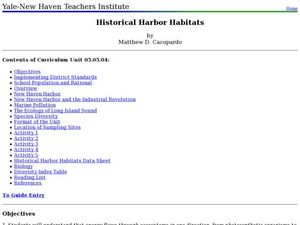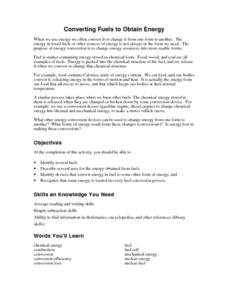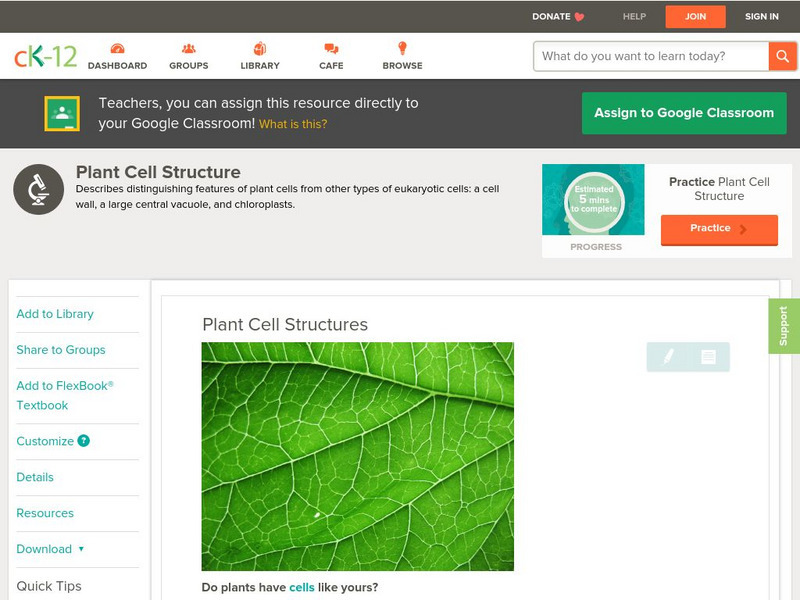Curated OER
Where Do Plants Get Their Food?
Students think about the historical development of the scientific method. They design an experiment that replicates van Helmont's, using only specified materials. Pupils then improved upon van Helmont's procedure and also consider the...
Curated OER
Historical Harbor Habitats
Tenth graders create food web displays in the classroom. In this ecology lesson, 10th graders identify the different pollutants in the environment and their effect on organisms. They collect samples of sediments from the harbor and...
Forest Foundation
The Nature of Trees
Young botanists examine the different parts of tress and then draw parallels between the functions of these parts and the function of parts of the human body.
Curated OER
Plankton in the Air
Here is a lab activity adequate for use with any full lesson on environmental factors that shape animal adaptations or marine animal characteristics. Pupils will discuss the role plankton plays in the environment and filter-feeding...
Serendip
Where Does a Plant's Mass Come From?
Where does the mass for a growing tree come from? Scholars consider a few different hypotheses and guess which is correct. They then analyze data from different experiments to understand which concepts science supports.
Curated OER
Build a Coral Polyp
Students build a coral polyp out of a banana, straw, oyster crackers, sprinkles, and more. For this coral polyp lesson plan, students also list the differences between plants and animals.
Curated OER
Spelling Dictation Sentences
In this spelling sentences worksheet, 5th graders practice spelling these dictation sentences for 2 sentences every week. Students spell a total of 72 sentences.
Curated OER
Chlorophyll
Students use thin layer chromatography, TLC, to separate various pigments found in plants.
Curated OER
Chemical Energy
In this science worksheet, learners fill in the blank for 15 sentences about chemical energy. For example, "Chemical bonds hold_."
Curated OER
Functions of Leaves
The title is a little deceiving since only one of 17 slides is dedicated to the function of leaves, while the rest is dedicated to the structure. Both internal and external structure is taught with accompanying diagrams. If you are going...
Curated OER
Converting Fuels to Obtain Energy
Students experiment with converting fuels to energy. They also must identify different types of fuels and ways to conserve energy.
Curated OER
Coral Polyp Party
Students complete a project where they label the parts of a coral polyp and discuss the differences between plants and animals. Students use marshmallows, sprinkles, toothpicks, and more to label their coral polyp.
Curated OER
I See a Coyote
Learners role-play coyotes looking for natural resources. In this natural resources lesson, students examine the relationship between animal life and the environment. Learners play a game that demonstrates how natural...
Curated OER
Ferns and Gymnosperms
In this fern and gymnosperm worksheet, students will read about two types of vascular tissue: xylem and phloem. Then students will read about the difference between sporophytes and gametophytes. Using this information students will...
Curated OER
Milkweed Monitoring
Ninth graders study milkweed and see how it is effected by ozone. In this air pollution lesson students complete a lab activity that includes data analysis.
Curated OER
Asexual Reproduction
In this asexual reproduction instructional activity, students compare and contrast different types of asexual reproduction processes by examining prepared slides and completing 20 short answer questions, 4 drawings, and 9 fill in the...
Curated OER
Kingdom Protista Crossword
In this crossword puzzle activity, 7th graders read the definitions that relate to the protista kingdom and then complete the crossword puzzle.
Curated OER
Algae
In this biology worksheet, students identify and locate various vocabulary terms pertaining to algae. There are 54 biology terms located in the word search.
CK-12 Foundation
Ck 12: Life Science: Plant Cell Structures
[Free Registration/Login may be required to access all resource tools.] Even though plants and animals are both eukaryotes, plant cells differ in some ways from animal cells. Plant cells have a large central vacuole, are surrounded by a...
Ducksters
Ducksters: Biology for Kids: Plant Cell Chloroplasts
Study the plant cell chloroplasts in the science of biology including their function, structure, and how they help make energy through the process of photosynthesis on this site.
CK-12 Foundation
Ck 12: Biology: Plant Tissues and Organs Study Guide
Review the main vocabulary and processes in plant tissues and organs.
Other
The Plant Cell: Teaching Tools in Plant Biology: Why Study Plants?
Plants are essential for all life and development. Teach your students about this incredible lifeforce with this teaching guide, lecture notes, and PowerPoint presentation. [PDF]
Utah State Office of Education
Utah Science: Introducing Cells!
Get to know cells, what they create, how to identify them, and how to tell whether they belong to a plant or an animal. Several activities
TeachEngineering
Teach Engineering: Photosynthesis Life's Primary Energy Source
This lesson covers the process of photosynthesis and the related plant cell functions of transpiration and cellular respiration. Students will learn how engineers can use the natural process of photosynthesis as an exemplary model of a...
























